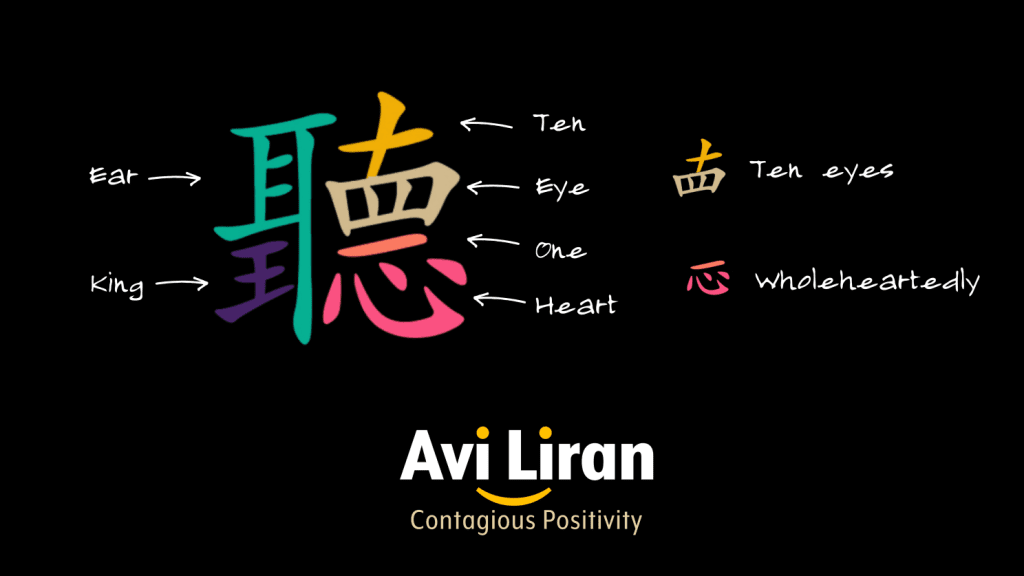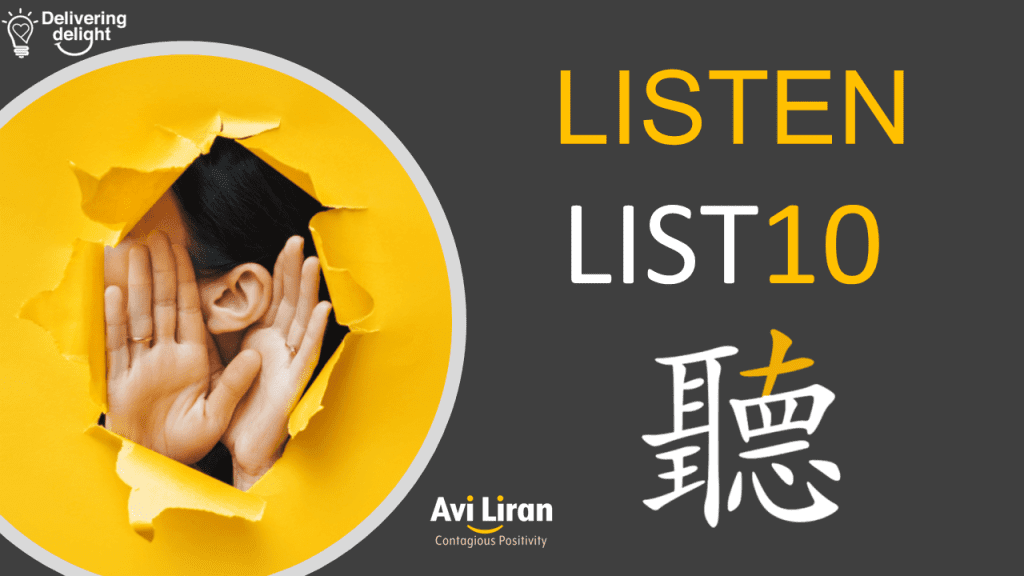A guide to unlocking the art of attentive listening
Ever catch yourself using auto-complete on what other people say, cutting them off halfway just so you can share your own brilliant thoughts? It’s like shooting an arrow and watching it circle the target, convincing yourself you’ve hit the bullseye.
In an era of rapid changes faster than F1 races, managers who fail to listen to their teams aren’t just missing out on a good chat, they’re also putting the brakes on creativity, innovation, and adaptation.
We all know the importance of being better listeners, so why don’t we put this theory into practice?
Here are 7 hacks that will instantly help you become a better listener if you apply them:
🛠 Hack 1: Just Listen
In one of our first Joy-Care Leadership advanced workshops for leaders of a global hospitality giant, we facilitated the “Just Listen” exercise. We asked leaders to engage in pure, unadulterated listening. The rules were simple: don’t speak, don’t nod, don’t even hum in agreement. Just be present and listen.

The leaders paired up and started to share and practice pure listening. And that’s when Lynn, the lovely HR Director Lynn started crying. The room went so quiet you could hear a pin drop. Everyone circled around her with concern, and Lenny and I, as the facilitators, were sweating bullets. But then Lynn reassured us, “Don’t worry, it’s a good cry”. Intrigued? So were we.
She explained, “For two years, our Executive Chef came to me every few months with the same request. And every time, I cut him off halfway and moved on to the next topic because I thought he was asking for something against our SOPs. I didn’t want to waste my time-fighting windmills.”
“But today, for the first time, I had to let him finish. And guess what? He wasn’t asking what I thought he was. I’m ashamed. I jumped to conclusions. I didn’t give Chef the basic respect of truly listening.”
The energy in the room shifted. Lynn’s vulnerability had touched everyone and etched the moment into everyone’s memory. With information explosion at our fingertips and stressful schedules, we often miss important points and possibilities because our mind is preoccupied with our agendas and assumptions.
“The Artist is Present,” Marina Abramović’s iconic performance at the Museum of Modern Art in 2010, was a powerful exploration of presence and connection. For hours, she sat motionless and silently at a table, inviting visitors to sit across from her for a single minute. The unspoken exchange, a shared moment of mutual presence, became a profound catalyst for emotional connection.
When her former lover and collaborator, Ulay, unexpectedly appeared, the performance took an even more poignant turn. Their silent reunion, decades after their separation, was a testament to the enduring power of human connection.
Abramović’s unwavering focus and emotional openness demonstrated the depth of presence that transcends words. By being fully present with another person, without distraction or judgment, she invited a profound sharing of experience and a powerful connection that resonated with viewers.


🛠 Hack 2: 聽 Listen Like a King
The Chinese character for “to listen,” 聽 (tīng), encapsulates a profound understanding of the act. Dating back to around 1,000 BCE, the ancient Chinese recognized listening as a holistic endeavor that engages the entire being. At its core, the character combines several elements:
- Ear (耳 ěr ): Let’s start clockwise from the top left part of the character, 耳 literally represents an “ear,” our auditory input organ. Pay attention to the spoken words and vocal nuances, revealing the speaker’s emotions and intentions.
- Ten (十) and Eyes (目): Clockwise to the top right is the character 十, representing “ten,” and below it 目, which means “eye.” Together, these elements suggest that listening involves paying total attention with “ten eyes,” to observe facial expressions, nonverbal cues, and body gestures. Are they congruent with what you hear?
- One (一) and Heart (心): Below the symbol of eyes, there is the character, 心, representing the “heart.” This indicates that listening is also about engaging “one heart” or better say “listening wholeheartedly” with empathy and understanding for building rapport and fostering deeper communication.
- King (王): Clockwise to the bottom left there is the symbol 王, which represents “king” or “ruler.” This implies that listening is a quality of leadership or something that one should do with the seriousness of a ruler. The three horizontal strokes represent Heaven, Man, and Earth. The vertical stroke is the king, the one who connects them together. Therefore the King stands for the result of combining the senses.


🛠 Hack 3: Listen With Your Heart
In the book Eat, Pray, Love, the author Elizabeth Gilbert, visits Ketut, an elderly Balinese healer and fortune teller, known for his profound wisdom. (I visited Ketut many years ago in Bali).
Ketut, with his charming toothless smile, presents Elizabeth with a drawing he created during meditation. The drawing is unlike anything she has ever seen. It depicts a human figure standing upright with four legs. Its head is replaced by a vibrant crown of leaves and flowers and a small, serene face is drawn over the heart.
Ketut explained the drawing’s significance: “To find the balance you want,” he says “this is what you must become. You must keep your feet grounded so firmly on the earth that it’s like you have four legs instead of two. That way, you can stay in the world. But stop looking at the world through your head. Look through your heart instead. That way, you will know God.”
Ketut’s drawing represents a profound message: to find balance and spiritual connection, one must be grounded and centered, like a creature with four legs firmly planted on the earth. The missing head isn’t a mistake; it’s a reminder to let go of mental clutter and ego, guiding you to connect with your heart and intuition instead. The floral crown atop this figure is a symbol of your soul’s growth, a blossoming of your spiritual self.


In the book The Little Prince, the fox imparts his wisdom to the Little Prince and says,
“It is only with the heart that one can see rightly; what is essential is invisible to the eye.” ~ Antoine de Saint-Exupery
The Little Prince listens intently, absorbing the lesson that love, connection, and the invisible bonds of friendship are what truly matter in life.
Our rational mind handles the nuts and bolts of logic, but the heart adds a bit of warmth by tuning into the emotions behind the words. Listening with your heart is like really getting what someone’s feeling, beyond what they’re saying. It makes conversations more enjoyable and helps you connect with people on a deeper, more genuine level. It’s where the magic in communication happens!
🛠 Hack 4: 10X
In his book Illusions: The Adventures of a Reluctant Messiah, Richard Bach wrote the quote “We teach best what we most need to learn.” I guess it is true for me too. To be honest, I was a disastrous listener. My ADHD brain is like a runaway train, I was missing the whole point of conversations: connecting!
I needed a change, but old habits die hard. Not listening made me an unappreciative boss, distracted friend, unempathetic, and a not-present family man.
Then it hit me. “LISTEN” can be broken into two parts: “𝗟𝗜𝗦𝗧-𝗧𝗘𝗡,” just like the number 10 in the Chinese character for listening.
My new challenge in each conversation? Learn at least 10 new things about someone I meet before I talk. Suddenly, listening was not only effective but also fun.
Tuning my ears to “curiosity mode” helped me uncover amazing stories.
Most people have incredible stories that, once uncovered, make them so much more special in my eyes. I often find myself feeling proud of them.
But be warned! You have to be genuinely interested. If you’re just faking it, trust me, it shows, and the magic won’t happen.
The “List-10” challenge kept me on my toes and sharpened my listening skills.
But hey, not every chat calls for a deep investigation, and I learned to balance my curiosity so it didn’t cross into nosy territory.


🛠 Hack 5: “Tell Me More”
One of the best ways to show genuine interest and curiosity in what someone is saying is by using the phrase “Tell me more.” This phrase transforms your mindset, helping you truly focus on learning more about the other person, which can be very useful later on.
This neutral phrase doesn’t imply approval or disapproval, helping you avoid being judgmental and allowing you to gather more information before jumping to conclusions.
It makes the speaker feel that their sharing is important to you. “Tell me more” creates a safe space for the speaker to open up and expand on their thoughts and feelings.
When you authentically show genuine interest in someone’s thoughts and feelings, it builds trust, and rapport, and deepens the relationship.


🛠 Hack 6: Be a Great Host (of Your Talk Show)
In the chorus of her song “One of Us,” Joan Osborne asks, “What if God was one of us? Just a stranger on a bus trying to make his way home. Would you recognize him?”
This hack is about becoming a superhost by treating the person you’re listening to as your VIP guest or an angel sent by the divine.
Picture yourself as a talk show host, and your guest is the star of the evening. Your goal isn’t just to nod along but to dig into the delightful stories behind their words, the kind that make the audience say, “I didn’t see that coming!”
This mindset shifts you from passive listening to active engagement, like when a host tosses out a zinger that brings out the guest’s best. You’ll find yourself asking all the right questions, the ones that reveal those hidden gems others might overlook.
This approach enriches the conversation and makes your guest feel like the most interesting person in the room. By embracing this host mentality, you’re not just listening to chat; you’re listening to uncover the magic, letting the conversation take on a life of its own.
Remember, a good host is always well-prepared. Spend a few minutes researching your guest on LinkedIn, liking, and commenting on their posts before meeting them. This effort can uncover amazing ice-breaker topics.
For example, last week I noticed my “guest” attended high school in Jakarta. When I mentioned it, he spent the next 10 minutes sharing how that period shaped him and how he kept in touch with his schoolmates. This small investment set a positive tone for our entire conversation.
Caution: Don’t probe too much. Ensure your “interviewee” feels safe and comfortable at all times, and always respect their boundaries.


🛠 Hack 7: Communicate Like Benjamin Disraeli
There’s a classic story about Queen Victoria and her two Prime Ministers, William Gladstone and Benjamin Disraeli, that offers a valuable lesson in effective communication.
Queen Victoria once said of Gladstone, “When I am with Mr. Gladstone, I feel I am with one of the most important people in the world.” Gladstone was like a walking encyclopedia. Conversations with him felt like attending a lecture, where his vast knowledge flowed like a tidal wave. Informative? Absolutely. Interactive? Not so much.
In contrast, the Queen remarked about Disraeli, “When I am with Mr. Disraeli, I feel I am one of the most important people in the world.” Disraeli had a unique charm and a knack for making others feel like the center of the universe. His conversations were not about showcasing his intelligence but about making you feel like the most interesting person in the room.
If you have the soul of a teacher or an advisor, be mindful not to preach during conversations or offer unsolicited advice. The moment someone says, “Thank you for your valuable advice,” a red flag should go up. You might be slipping into the Gladstone style of communication.


Call to Action
Give these listening tricks a try, and watch the magic unfold! Suddenly, your conversations will start to click like a well-oiled machine, with misunderstandings becoming a thing of the past.
Relationships? They’ll start blooming like a garden in spring. You’ll notice that people open up more when they feel genuinely heard, and guess what? It makes everything from problem-solving to just hanging out so much more fun.
As a leader, you’ll find that listening is your ticket to creating a work environment where everyone’s on the same page and genuinely happier to be there. It’s like turning on the lights in a dim room. Everything brightens up!








